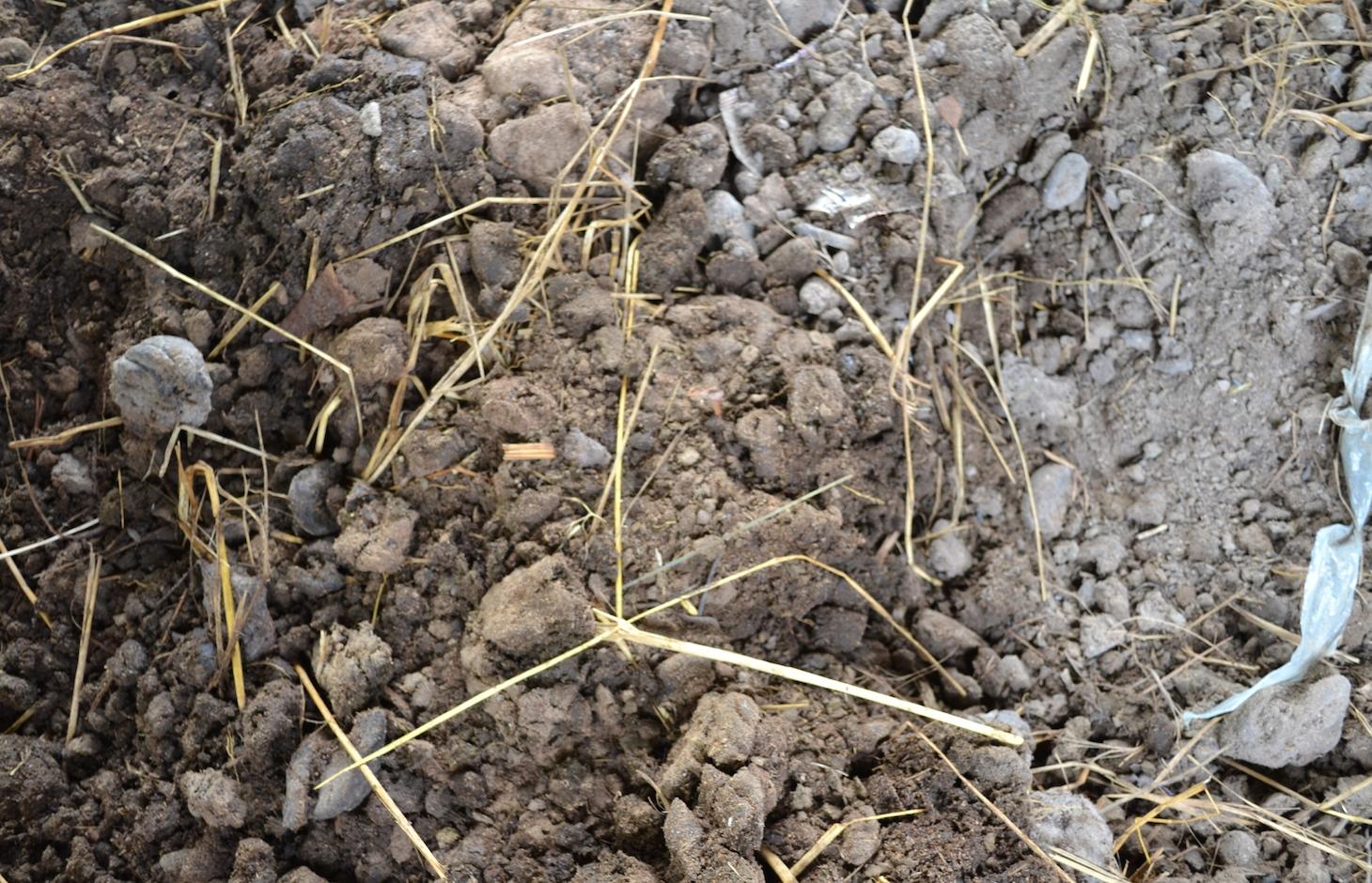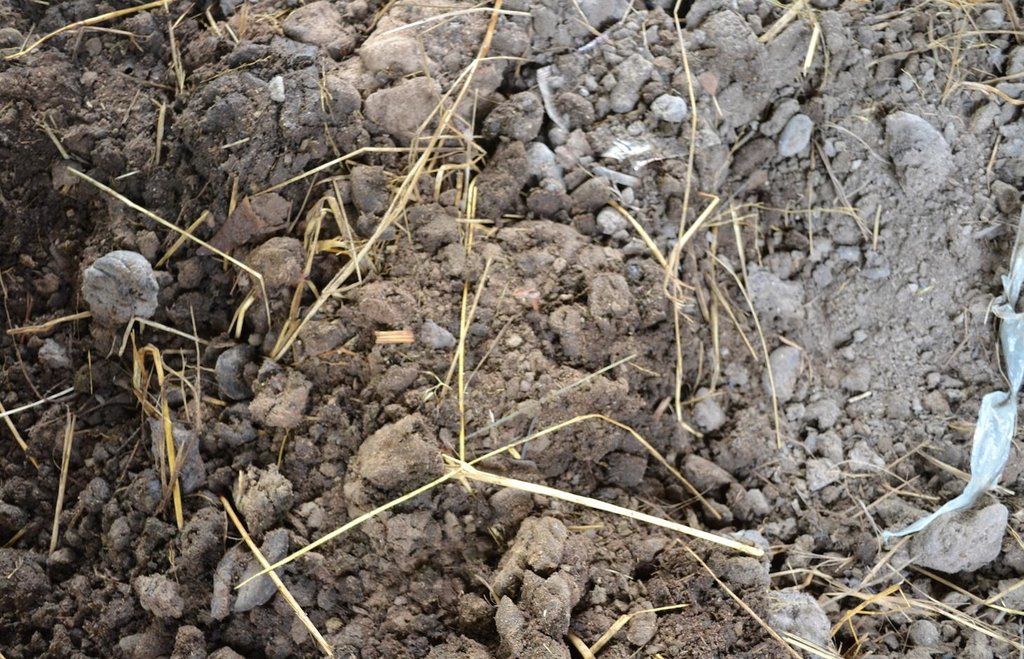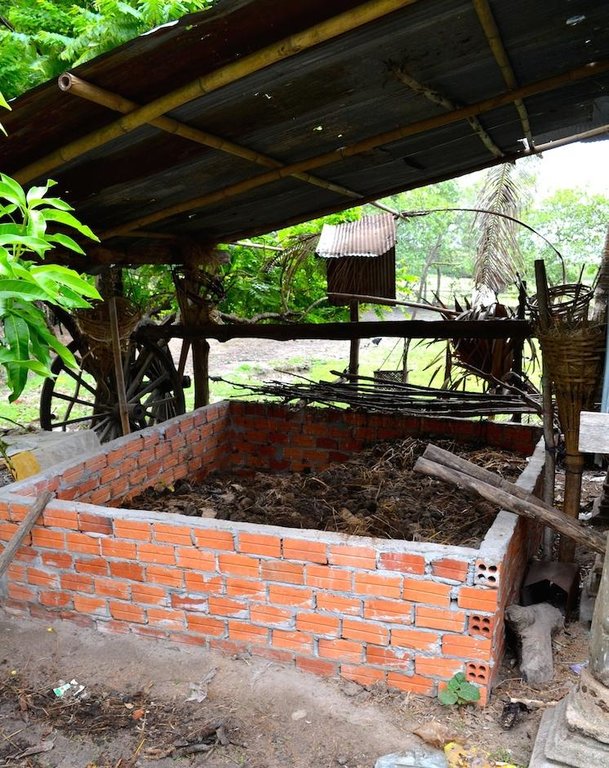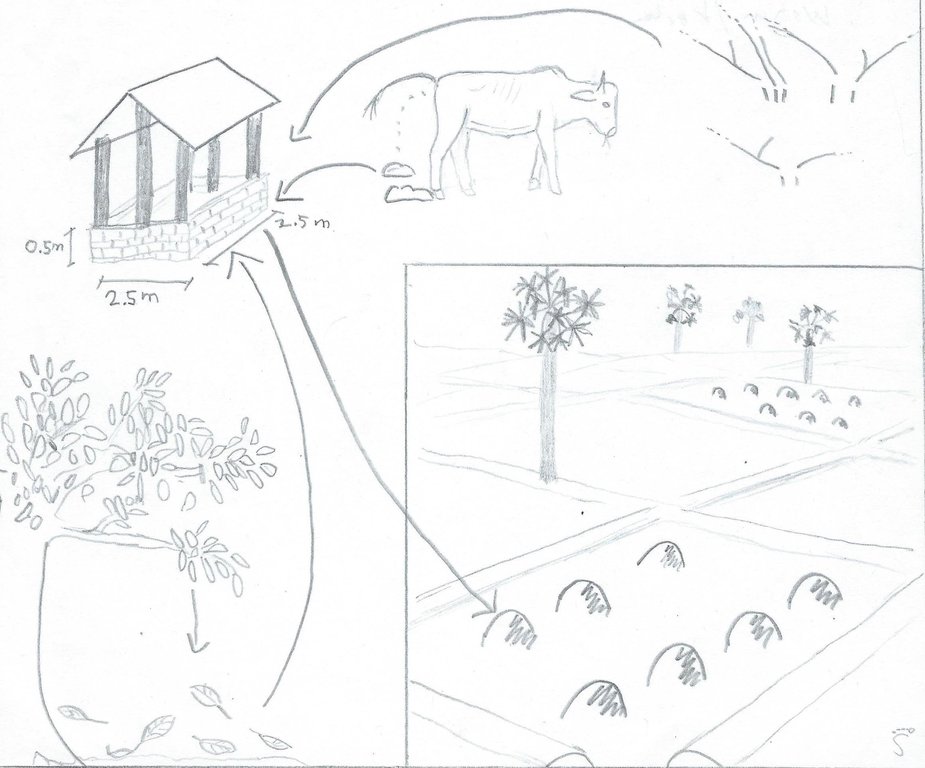Compost application on rice fields [柬埔寨]
- 创建:
- 更新:
- 编制者: Christoph Kaufmann
- 编辑者: –
- 审查者: Alexandra Gavilano, Deborah Niggli, Nina Lauterburg
ការប្រើប្រាស់ជីកំប៉ុស្តិ៏នៅក្នុងស្រែ (Khmer)
technologies_1218 - 柬埔寨
查看章节
全部展开 全部收起1. 一般信息
1.2 参与该技术评估和文件编制的资源人员和机构的联系方式
SLM专业人员:
SLM专业人员:
Khonhel Pith
Local Agricultural Research and Extension Centre LAREC
柬埔寨
SLM专业人员:
Mesa Say
Society for Community Development in Cambodia SOFDEC
柬埔寨
SLM专业人员:
Sreytouch Bin
Society for Community Development in Cambodia SOFDEC
柬埔寨
有助于对技术进行记录/评估的机构名称(如相关)
CDE Centre for Development and Environment (CDE Centre for Development and Environment) - 瑞士1.3 关于使用通过WOCAT记录的数据的条件
编制者和关键资源人员接受有关使用通过WOCAT记录数据的条件。:
是
1.4 所述技术的可持续性声明
这里所描述的技术在土地退化方面是否存在问题,导致无法被认为是一种可持续的土地管理技术?:
否
1.5 参考关于SLM方法(使用WOCAT记录的SLM方法)的调查问卷

Model farmer [柬埔寨]
Model farms were introduced by a NGO in order to spread knowledge about SLM (compost, System of Rice Intensification SRI, and other technologies) in the project area.
- 编制者: Christoph Kaufmann
2. SLM技术的说明
2.1 技术简介
技术定义:
Manure, leaves and rice straw are gathered in a compost house and the produced compost is applied twice a year to the rice field.
2.2 技术的详细说明
说明:
Compost is produced in compost houses and is seen as a good and easy soil amendment. It is produced by mixing organic components (in this case study cow manure, rice straw, different leaves and ash) which are locally available. The ideal mix of ingredients shows an N-to-C ratio of approximately 1 to 25. By adding compost to the topsoil, its humus content is increased, and therefore the soil fertility and water holding capacity are enhanced. Although the technology can be applied with little technological knowledge, the land user’s workload is augmented. This can be detrimental in a human environment with constantly decreasing available labour force.
The purposes of compost production are multifaceted. From the land user’s point of view, the increased yields are certainly one of the most determining factors. This is due to the augmentation of organic matter and nutrients in the topsoil which results in a higher soil fertility. Therefore, the use of chemical fertilizer can be diminished while the yields stay the same. This results in the amelioration of the land user’s livelihood, since he needs to buy less fertilizer. Also, the improved soil structure (according to the land user, the soil is softer and easier to cultivate) and water retention capacity are of importance in this area, since the soils are sandy/loamy, and due to climate change the rainfall is more erratic and droughts more recurrent. Compost also buffers the soil’s pH and prevents acidification. As a consequence, the nutrient availability is increased. Finally, compost adds more biota to the soil.
First, the compost house is built. This can be done either with external inputs such as bricks, cement, and a tin roof (the initial investment is higher, but the recurrent maintenance activities lower), or with locally available, natural inputs such as rice straw and clay for the walls and dried sugar palm leaves for the roof (the initial investment is lower, however there are more recurrent maintenance activities which can be detrimental for the continuation of compost production).
Once the compost house is built, the organic matter (approximately 70 % cow manure, and 30 % rice straw and different leaves, with a small amount of ash) is collected in the surroundings and carried to the compost house. In this case study, compost is produced once during the dry season and once during the wet season. During the dry season, water is added to the organic matter in order to facilitate the composting process. Ideally, the organic matter should be turned in order to guarantee a complete composting process. However, this includes a rather big workload. As a result, turning is not always practiced in the area (high migration rates result in a decrease of available labour force).
When the composting process is completed, the compost is carried to the fields with the use of animal traction. This is done several times: once when the fields are plowed, once when the rice seedlings are transplanted and once while the rice is growing (“top dressing”).
The analyzed area is flat (slope < 2%), with a tropical climate with a (dry and a wet season), and the soils are mostly sandy or loamy. The soils have a low fertility, contain little organic matter, the pH is sinking, the area has been deforested a long time ago and the groundwater table is rather high (1-2 m during the dry season, on the surface during wet season).
Due to climate change, land users notice more erratic rainfalls, temperatures rise and more recurrent droughts. Rice is the predominant crop grown in the area, since it serves as staple food (mix subsistence and commercial activities). Rice is often grown in monocultures and harvested once a year. Once the rice is harvested (dry season), the cattle are released to the paddy fields.
As an addition to rice, most land users grow vegetable and fruits in small home gardens (subsistence) and complement their income by producing handicrafts or through off farm income / remittances from family members working in other places. The increasing migration rate (the young generation leaves the villages to work in the cities, garment industry or abroad) results in a decrease of available labour force in the area. This has detrimental effects on the agricultural activities. Furthermore, the civil war in the 1970s (Khmer Rouge) led to the loss of agricultural knowledge.
2.3 技术照片
2.5 已应用该技术的、本评估所涵盖的国家/地区/地点
国家:
柬埔寨
区域/州/省:
Kampong Chhnang
有关地点的进一步说明:
Rolear Pha-er
具体说明该技术的分布:
- 均匀地分布在一个区域
如果不知道精确的区域,请注明大致覆盖的区域:
- 10-100 平方千米
2.6 实施日期
如果不知道确切的年份,请说明大概的日期:
- 不到10年前(最近)
2.7 技术介绍
详细说明该技术是如何引入的:
- 通过项目/外部干预
注释(项目类型等):
A local NGO provided a training on compost making, about 5 years ago.
3. SLM技术的分类
3.1 该技术的主要目的
- 减少、预防、恢复土地退化
- 降低灾害风险
3.2 应用该技术的当前土地利用类型
同一土地单元内混合使用的土地::
是
具体说明混合土地使用(作物/放牧/树木):
- 农牧业(包括农牧结合)

农田
- 一年一作
年作 - 具体指明作物:
- 谷类 - 水稻(湿地)
每年的生长季节数:
- 1
具体说明:
Longest growing period in days: 210, Longest growing period from month to month: June - December

牧场
动物类型:
- 牛 - 非奶牛牛肉
- 牛 - 非乳制品工作
注释:
Major land use problems (compiler’s opinion): Lack of organic matter, lack of water retention in soil, irregularity of rainfall, low soil fertility (sandy soil), monocultures, bare soil during dry season, ploughing.
Major land use problems (land users’ perception): Rice field: lack of nutrients, need fertilizer and compost otherwise no good yield. Not enough compost available, need to use also small amount of chemical fertilizer even though compost is applied. Lack of water. Soil erosion.
3.4 供水
该技术所应用土地的供水:
- 混合雨水灌溉
3.5 该技术所属的SLM组
- 改良的地面/植被覆盖
3.6 包含该技术的可持续土地管理措施

农艺措施
- A2:有机质/土壤肥力
- A3:土壤表面处理
3.7 该技术强调的主要土地退化类型

化学性土壤退化
- Cn:肥力下降和有机质含量下降(非侵蚀所致)
- Ca:酸化

生物性退化
- Bl:土壤寿命损失
注释:
Main causes of degradation: soil management (Ploughing, soil is left bare for several weeks), crop management (annual, perennial, tree/shrub) (Rice monoculture (rice serves as staple food)), change of seasonal rainfall (More erratic beginning of wet season), droughts (On dry soil, rice cannot be planted and if already planted, rice cannot grow), labour availability (High migration rates from the villages to garment industry, cities or abroad, influences agricultural activities (e.g. broadcasting instead of transplanting of rice seedlings)), education, access to knowledge and support services (Khmer Rouge regime in the 1970s, a lot of knowledge got lost.)
Secondary causes of degradation: over-exploitation of vegetation for domestic use (Rice straw is removed for different domestic uses (cattle, mushroom cultivation, etc.)), overgrazing (Cattle eats rice straw left after harvest, less organic matter on the field, grazing is not managed.), change in temperature, Heavy / extreme rainfall (intensity/amounts), land tenure (Some incidents of land grabbing, land use rights not clear), poverty / wealth
3.8 防止、减少或恢复土地退化
具体数量名该技术与土地退化有关的目标:
- 减少土地退化
- 修复/恢复严重退化的土地
4. 技术规范、实施活动、投入和成本
4.1 该技术的技术图纸
技术规范(与技术图纸相关):
Manure, straw, ash and leaves are gathered in a compost hut, and later on dispersed on the paddy fields.
Kampong Chhnang
Technical knowledge required for field staff / advisors: moderate
Technical knowledge required for land users: low (It is not difficult to make compost, however it increases the workload of the land user. This might lead to the adaptation of the Technologies in order to decrease the additional workload.)
Main technical functions: increase in organic matter, increase in nutrient availability (supply, recycling,…)
Secondary technical functions: increase / maintain water stored in soil
Manure / compost / residues
Material/ species: Cow manure, mango leaves, rice straw, wood ash, green plants.
Quantity/ density: 3.7 t/ha
Remarks: 1 part at the beginning of the rainy season (rice transplantation), 1 part during the growing period
作者:
Stefan Graf
4.2 有关投入和成本计算的一般信息
具体说明成本计算所用货币:
- 美元
注明雇用劳工的每日平均工资成本:
5.00
4.3 技术建立活动
| 活动 | 时间(季度) | |
|---|---|---|
| 1. | Construction of compost house | |
| 2. | Clay: Dig pit (10 cm) and add clay from the rice field | |
| 3. | Bricks and cement: make brick walls | |
| 4. | iron roof | |
| 5. | poles | |
| 6. | nails | |
| 7. | labour |
4.4 技术建立所需要的费用和投入
| 对投入进行具体说明 | 单位 | 数量 | 单位成本 | 每项投入的总成本 | 土地使用者承担的成本% | |
|---|---|---|---|---|---|---|
| 劳动力 | labour | 1.0 | 20.0 | 20.0 | 100.0 | |
| 施工材料 | iron roof | 1.0 | 15.0 | 15.0 | 100.0 | |
| 施工材料 | bricks and cement | 1.0 | 31.0 | 31.0 | 100.0 | |
| 施工材料 | poles and nails | 5.0 | 1.0 | 5.0 | 100.0 | |
| 技术建立所需总成本 | 71.0 | |||||
| 技术建立总成本,美元 | 71.0 | |||||
4.5 维护/经常性活动
| 活动 | 时间/频率 | |
|---|---|---|
| 1. | Gather material for compost, prepares compost and adds water in dry season | all year round |
| 2. | Bring compost to fields | June - September |
4.6 维护/经常性活动所需要的费用和投入(每年)
| 对投入进行具体说明 | 单位 | 数量 | 单位成本 | 每项投入的总成本 | 土地使用者承担的成本% | |
|---|---|---|---|---|---|---|
| 劳动力 | labour | 1.0 | 140.0 | 140.0 | 100.0 | |
| 技术维护所需总成本 | 140.0 | |||||
| 技术维护总成本,美元 | 140.0 | |||||
注释:
Machinery/ tools: Please note that the interviewed land user owns cows that are used for bringing the compost to the field. Hence, the costs for animal traction in this case study are zero.
1 compost house, around 4m^3.
4.7 影响成本的最重要因素
描述影响成本的最决定性因素:
Cost are affected by the availability of material to build the compost house (bricks, roof, etc.), which can be used long term.
Locally available, free material (sugar palm leaves for the roof, straw and clay for the walls) can be used as well, but it decays more quickly than the material used in this case-study (more recurrent maintenance activities).
The transport of manure to the fields is also an important expense. It is often done with the ox carts. As nearly all families owning oxen have a cart for different uses (firewood and product transportation), it is difficult to calculate this cost
5. 自然和人文环境
5.1 气候
年降雨量
- < 250毫米
- 251-500毫米
- 501-750毫米
- 751-1,000毫米
- 1,001-1,500毫米
- 1,501-2,000毫米
- 2,001-3,000毫米
- 3,001-4,000毫米
- > 4,000毫米
农业气候带
- 半湿润
Thermal climate class: tropics. 27°C to 35°C
5.2 地形
平均坡度:
- 水平(0-2%)
- 缓降(3-5%)
- 平缓(6-10%)
- 滚坡(11-15%)
- 崎岖(16-30%)
- 陡峭(31-60%)
- 非常陡峭(>60%)
地形:
- 高原/平原
- 山脊
- 山坡
- 山地斜坡
- 麓坡
- 谷底
垂直分布带:
- 0-100 m a.s.l.
- 101-500 m a.s.l.
- 501-1,000 m a.s.l.
- 1,001-1,500 m a.s.l.
- 1,501-2,000 m a.s.l.
- 2,001-2,500 m a.s.l.
- 2,501-3,000 m a.s.l.
- 3,001-4,000 m a.s.l.
- > 4,000 m a.s.l.
5.3 土壤
平均土层深度:
- 非常浅(0-20厘米)
- 浅(21-50厘米)
- 中等深度(51-80厘米)
- 深(81-120厘米)
- 非常深(> 120厘米)
土壤质地(表土):
- 粗粒/轻(砂质)
- 中粒(壤土、粉土)
表土有机质:
- 低(<1%)
5.4 水资源可用性和质量
地下水位表:
< 5米
地表水的可用性:
中等
水质(未处理):
良好饮用水
5.5 生物多样性
物种多样性:
- 低
5.6 应用该技术的土地使用者的特征
生产系统的市场定位:
- 生计(自给)
- 混合(生计/商业)
非农收入:
- 收入的10-50%
相对财富水平:
- 贫瘠
- 平均水平
个人或集体:
- 个人/家庭
性别:
- 女人
- 男人
说明土地使用者的其他有关特征:
Difference in the involvement of women and men: The application of compost depends mainly on the commitment of the land users – gender and level of wealth are not determinative. However, the work is divided between men and women (physical strength).
Population density: 10-50 persons/km2
Annual population growth: 0.5% - 1%
Off-farm income specification: The land user manufactures handicrafts that she sells. Also, one of her daughters works in the garment industry. In addition, she owns pigs and chicken she sells.
5.7 应用该技术的土地使用者使用的平均土地面积
- < 0.5 公顷
- 0.5-1 公顷
- 1-2 公顷
- 2-5公顷
- 5-15公顷
- 15-50公顷
- 50-100公顷
- 100-500公顷
- 500-1,000公顷
- 1,000-10,000公顷
- > 10,000公顷
这被认为是小规模、中规模还是大规模的(参照当地实际情况)?:
- 小规模的
5.8 土地所有权、土地使用权和水使用权
土地所有权:
- 州
- 个人,未命名
土地使用权:
- 个人
用水权:
- 自由进入(无组织)
5.9 进入服务和基础设施的通道
健康:
- 贫瘠
- 适度的
- 好
教育:
- 贫瘠
- 适度的
- 好
技术援助:
- 贫瘠
- 适度的
- 好
就业(例如非农):
- 贫瘠
- 适度的
- 好
市场:
- 贫瘠
- 适度的
- 好
能源:
- 贫瘠
- 适度的
- 好
道路和交通:
- 贫瘠
- 适度的
- 好
饮用水和卫生设施:
- 贫瘠
- 适度的
- 好
金融服务:
- 贫瘠
- 适度的
- 好
6. 影响和结论性说明
6.1 该技术的现场影响
社会经济效应
生产
作物生产
注释/具体说明:
The farmer uses less chemical fertilizer. The yields remain the same on the short term.
收入和成本
农业投入费用
工作量
社会文化影响
食品安全/自给自足
注释/具体说明:
Less chemical fertilizer used
冲突缓解
contribution to human well-being
注释/具体说明:
Due to the use of compost, land users are less dependent on chemical fertilizers. Therefore, the cost of production decreases while the income remains the same.
生态影响
土壤
养分循环/补给
土壤有机物/地下C
6.3 技术对渐变气候以及与气候相关的极端情况/灾害的暴露和敏感性(土地使用者认为的极端情况/灾害)
渐变气候
渐变气候
| 季节 | 增加或减少 | 该技术是如何应对的? | |
|---|---|---|---|
| 年温度 | 增加 | 好 |
气候有关的极端情况(灾害)
气象灾害
| 该技术是如何应对的? | |
|---|---|
| 局地暴雨 | 好 |
| 局地风暴 | 好 |
气候灾害
| 该技术是如何应对的? | |
|---|---|
| 干旱 | 好 |
水文灾害
| 该技术是如何应对的? | |
|---|---|
| 比较和缓的(河道)洪水 | 好 |
其他气候相关的后果
其他气候相关的后果
| 该技术是如何应对的? | |
|---|---|
| 缩短生长期 | 好 |
6.4 成本效益分析
技术收益与技术建立成本相比如何(从土地使用者的角度看)?
短期回报:
中性/平衡
长期回报:
积极
技术收益与技术维护成本/经常性成本相比如何(从土地使用者的角度看)?
短期回报:
中性/平衡
长期回报:
积极
6.5 技术采用
- 11-50%
如若可行,进行量化(住户数量和/或覆盖面积):
15% of land user families have adopted the Technology with external material support 20 land user families have adopted the Technology with external material support
在所有采用这项技术的人当中,有多少人是自发的,即未获得任何物质奖励/付款?:
- 51-90%
注释:
Comments on acceptance with external material support: The technology was first introduced by a training (20 people attended), and then the neighbors of these farmers copied it. For each farmer trained, approximately 5 neighbors copied the technology.
85% of land user families have adopted the Technology without any external material support
130 land user families have adopted the Technology without any external material support
There is no trend towards spontaneous adoption of the Technology. Compost making increases the workload of the land users an that impedes the spontaneous adoption of the Technology.
6.7 该技术的优点/长处/机会
| 土地使用者眼中的长处/优势/机会 |
|---|
| Less chemical fertilizer is used for the same yield, so the farmer can save money since she buys less chemical fertilizer. |
| Soil fertility is better. She sees more earthworms in the fields. |
| Ploughing became easier, because the soil is less hard after compost application. |
| 编制者或其他关键资源人员认为的长处/优势/机会 |
|---|
| Low cost, locally available and effective fertilizer/soil improving material. |
| Soil quality (organic matter, nutrient content, water retention, soil biota) is improved |
| The resilience is increased; farmers are less dependent on external inputs (fertilizer…) |
| Long term increased yields. |
6.8 技术的弱点/缺点/风险及其克服方法
| 土地使用者认为的弱点/缺点/风险 | 如何克服它们? |
|---|---|
| The collection of the material and the preparation of the compost (turning) is time consuming. | Monitoring the cost/benefit ratio to show the benefit to the farmer |
| It is difficult to transport the compost to the field. | Collaboration between neighbors to lower costs of hiring someone or lending machines. |
| She cannot make enough compost for all the fields | Work toward an integrated production. |
| 编制者或其他关键资源人员认为的弱点/缺点/风险 | 如何克服它们? |
|---|---|
| Not enough organic matter to make enough compost (number of cattle is low, rice monoculture). | Work toward an integrated production. |
| Increased workload while labour availability is decreasing due to migration. | Increase the handicraft work on the farms. Diversification of the production with less labour intensive species. |
| Low motivation of the land user because the composting work has to be done each year again. | Monitoring to show the long-term cost/benefit ratio. |
| The composting process is not completely understood; weed and rice seeds survive and are growing on the fields. | Explanations about seed survival and dormancy to explain the purpose of composting. |
7. 参考和链接
7.1 信息的方法/来源
- 实地考察、实地调查
- 与土地使用者的访谈
(现场)数据是什么时候汇编的?:
23/06/2014
7.2 参考可用出版物
标题、作者、年份、ISBN:
Society for Community Development in Cambodia SOFDEC
可以从哪里获得?成本如何?
www.sofdec.org
链接和模块
全部展开 全部收起链接

Model farmer [柬埔寨]
Model farms were introduced by a NGO in order to spread knowledge about SLM (compost, System of Rice Intensification SRI, and other technologies) in the project area.
- 编制者: Christoph Kaufmann
模块
无模块





